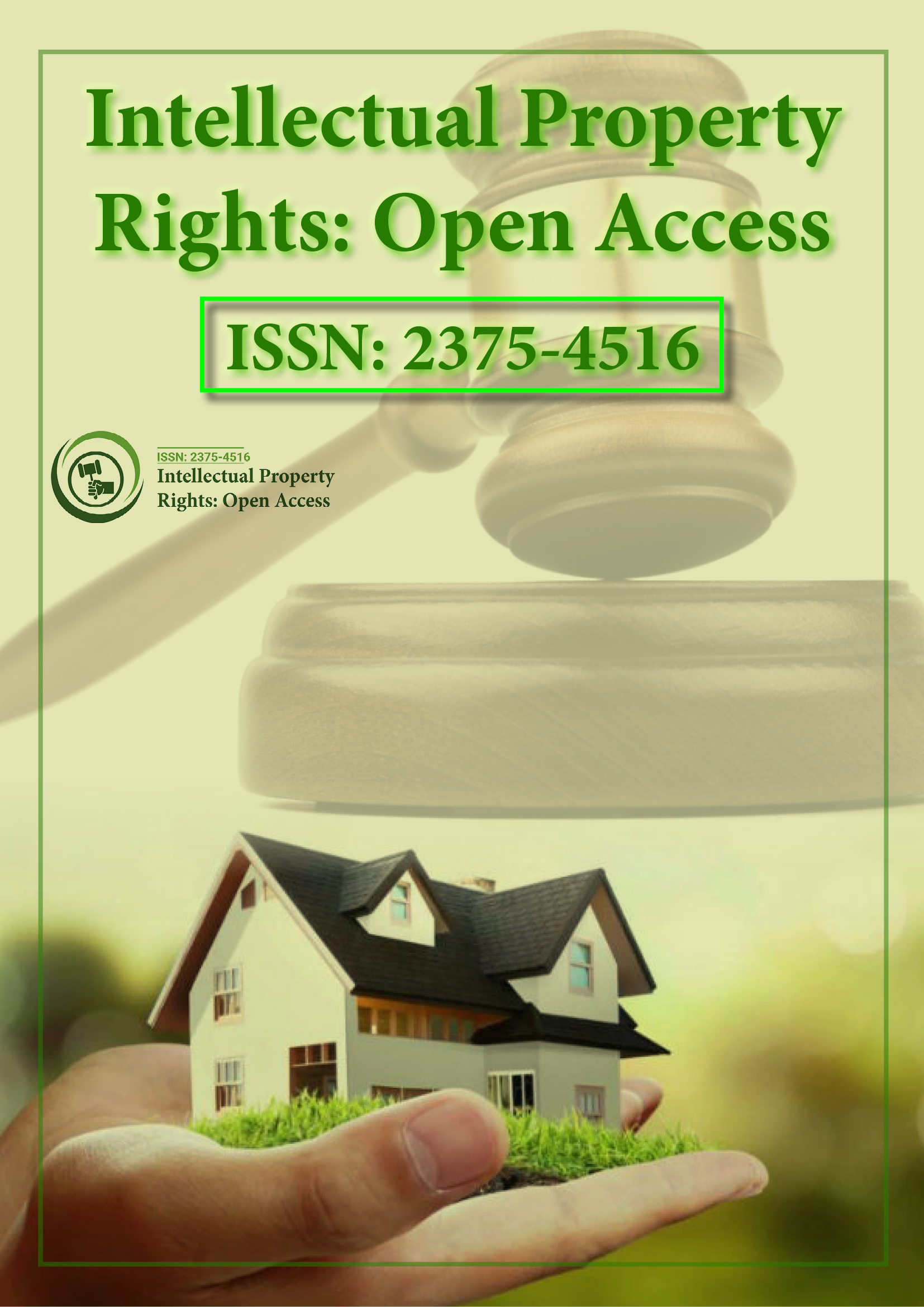Indexed In
- Open J Gate
- RefSeek
- Hamdard University
- EBSCO A-Z
- OCLC- WorldCat
- SWB online catalog
- Publons
Useful Links
Share This Page
Journal Flyer

Open Access Journals
- Agri and Aquaculture
- Biochemistry
- Bioinformatics & Systems Biology
- Business & Management
- Chemistry
- Clinical Sciences
- Engineering
- Food & Nutrition
- General Science
- Genetics & Molecular Biology
- Immunology & Microbiology
- Medical Sciences
- Neuroscience & Psychology
- Nursing & Health Care
- Pharmaceutical Sciences
Commentary - (2023) Volume 11, Issue 3
Innovation and Bridging Global Intellectual Property Gaps in World Intellectual Property Organization
Wen Hanyu*Received: 17-Aug-2023, Manuscript No. IPR-23-23329; Editor assigned: 21-Aug-2023, Pre QC No. IPR-23-23329 (PQ); Reviewed: 04-Sep-2023, QC No. IPR-23-23329; Revised: 11-Sep-2023, Manuscript No. IPR-23-23329 (R); Published: 19-Sep-2023, DOI: 10.35248/2375-4516.23.11.245
Description
In the modern, interconnected world, ideas are the key role for progress. Protecting these ideas, fostering innovation, and ensuring equitable access to knowledge are critical aspects of global development. The World Intellectual Property Organization (WIPO) stands at the forefront of this endeavor. Established in 1967, WIPO has become a driving force behind the harmonization of global Intellectual Property (IP) policies, promoting creativity, innovation, and the sharing of knowledge.
Origins and evolution of WIPO
WIPO, a specialized agency of the United Nations, traces its roots to the 1883 Paris Convention for the Protection of Industrial Property, an international treaty that aimed to safeguard intellectual property across borders. Over the years, the organization has evolved, adapting to the changing needs of the global community. In 1967, WIPO became a fully-fledged agency of the UN, entrusted with promoting and protecting intellectual property rights worldwide.
Core functions of WIPO
WIPO fulfills a diverse range of functions aimed at innovation, protecting intellectual property, and ensuring its benefits are shared globally:
International treaties and standardization: WIPO develops and administers international treaties and agreements related to intellectual property, providing a framework for harmonized IP regulations across countries.
IP registration and protection: WIPO facilitates the registration of patents, trademarks, industrial designs, and copyrights, ensuring creators and innovators receive legal protection for their intellectual creations.
Capacity building and technical assistance: WIPO provides technical assistance and capacity-building programs to developing countries, empowering them to create effective IP systems and leverage intellectual property for economic development.
Research and development: The organization conducts extensive research on intellectual property, producing valuable reports and publications that inform global policies and strategies.
Dispute resolution: WIPO offers services for the resolution of intellectual property disputes, providing a neutral and efficient platform for resolving conflicts without costly legal battles.
Impact on innovation and knowledge sharing
WIPO’s influence on the global innovation landscape is profound and far-reaching:
Encouraging innovation: By providing a robust framework for the protection of intellectual property rights, WIPO fosters innovation by enabling creators and inventors to invest in research and development with the assurance that their ideas are protected.
Facilitating technology transfer: WIPO plays a vital role in facilitating the transfer of technology and knowledge between nations, particularly benefiting developing countries, which can access essential technologies to address pressing challenges.
Promoting cultural exchange: Through copyright protection and related rights, WIPO supports the creation and dissemination of cultural works, encouraging diverse expressions of creativity and preserving the world's cultural heritage.
Global knowledge sharing: WIPO’s initiatives facilitate the sharing of scientific, technical, and cultural knowledge across borders, fostering international collaboration and understanding.
Challenges and future directions
Despite its significant contributions, WIPO faces challenges in an ever-changing global landscape:
Balancing rights and access: Striking a balance between protecting intellectual property rights and ensuring affordable access to essential goods, such as medicines, remains a challenge, especially in the context of public health crises.
Emerging technologies: Rapid advancements in technologies such as artificial intelligence, blockchain, and genetic engineering raise new questions about intellectual property rights, requiring continual adaptation of existing frameworks.
Piracy and counterfeiting: The rise of online piracy and the spread of substitute goods in the digital age pose significant challenges to IP protection, necessitating innovative solutions to combat these issues effectively.
Strengthening global intellectual property cooperation
To address these challenges and chart a path forward, international collaboration and cooperation are imperative:
Promoting education and awareness: Raising awareness about the importance of intellectual property rights and their impact on innovation is important. Education initiatives can empower individuals and businesses to protect their creations effectively.
Enhancing collaboration: WIPO can continue fostering collaboration between governments, businesses, academia, and civil society to develop innovative solutions to emerging challenges, ensuring that intellectual property frameworks remain relevant and effective.
Embracing technological solutions: Control emerging technologies such as blockchain for intellectual property management can enhance transparency, security, and efficiency in IP systems, reducing piracy and counterfeiting.
Supporting developing nations: Providing targeted support and technical assistance to developing countries can empower them to build robust intellectual property systems, fostering innovation, economic growth, and global integration.
Conclusion
In a world where ideas fuel progress and innovation drives economies, the role of WIPO as a guardian of intellectual property rights cannot be overstated. By promoting creativity, protecting inventions, and ensuring equitable access to knowledge, WIPO stands as a beacon of progress in the global intellectual property landscape. As it navigates the challenges of the future, WIPO's commitment to fostering innovation and enabling the global exchange of ideas will continue to shape the course of human development, driving innovation, fostering cultural exchange, and building a brighter future for generations to come.
Citation: Hanyu W (2023) Innovation and Bridging Global Intellectual Property Gaps in World Intellectual Property Organization. Intel Prop Rights. 11:245.
Copyright: © 2023 Hanyu W. This is an open access article distributed under the terms of the Creative Commons Attribution License, which permits unrestricted use, distribution, and reproduction in any medium, provided the original author and source are credited.
